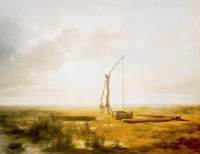
Markó who had not visited his country for 31 years was thrilled at the idea of returning to Hungary for however short a time. In order to express his commitment to his country, he painted the Great Hungarian Plain with characteristic motifs, i.e. swing poles surrounded by fountain throughs and storks still in l'Alpeggi from memory. He selected harmonious colours of sunset: as in the case of his pictures painted in Italy, he could not break away from ochrish, reddish-brownish shades. Perhaps he intended to go beyond limited colours when he repainted the picture in Vienna on his way to Budapest. Hungarian Steppe, a picture of the same size, is dominated by pale greens with double rainbow that is shining over the steppe lost in the horizon after the rain. The atmospheric unity of earth and sky is retained in the range of colder colours as well in the warmer. Landscape with swing pole, a symbol of Hungarian landscape, appeared in patriotic poetry of Sándor Petőfi and János Arany, and in paintings of Miklós Barabás and Markó Jun., in 1838. It became a favourite motif with Károly Lotz from the 1850s onwards, and it is still a popular one. The Hungarian steppe as a symbol from the very beginning expresses lazy barrenness, hopeless monotony of the Hungarian waste land on the one hand, and the unbreakable longing of Hungarians for freedom on the other.